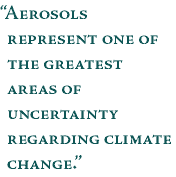

Aerosol Emissions | |||
Smoke and aerosol particles from large-scale biomass burning can rise high into the troposphere and be carried long distances by wind currents. Smoke plumes from Mexico have traveled as far north as Wisconsin and the Dakotas, and as far east as Florida and out over the Gulf Stream.
Aerosols have a two-fold cooling effect on climate. In the open atmosphere, they scatter and absorb incoming solar radiation, thereby reducing the amount of sunlight that reaches the surface. Moreover, aerosols act as "seeds"—called cloud condensation nuclei. When clouds form in the polluted atmosphere, the clouds' droplets tend to be smaller and more numerous. Because polluted clouds are typically comprised of more densely-packed droplets, they are more efficient at absorbing and reflecting sunlight, again having a cooling effect on the surface. Aerosols represent one of the greatest areas of uncertainty regarding climate change, both on global and regional scales. Scientists do not fully understand the magnitude of their cooling influence on climate. Scientists do not know which of the emission products exerts the greater net effect on regional and global climate—the cooling influence of aerosols and clouds, or the warming influence of the greenhouse gases. Because both types of emission products change rapidly through time and space, they are difficult to observe and characterize. In the future, the greenhouse gas warming is expected to dominate due to the gases' much longer presence in the atmosphere (10-100 years) than that of aerosol particles (7 days). next: NASA and NOAA Missions for Monitoring Global Fires |
 Global Fire Monitoring Related Case Studies
Related Data Sets
Above Left: Smoke from fires in Guatemala and Mexico on May 14, 1998, drifted across the Gulf of Mexico and triggered air quality warnings along the U.S. Gulf Coast. In addition to human health concerns, smoke particles affect rainfall rates and global climate. (Image by Norman Kuring, NASA SeaWiFS Project) | ||